Situated in the middle of Brooklyn, this plaza includes some notable must-sees for those visiting the area.
The Construction of the Plaza
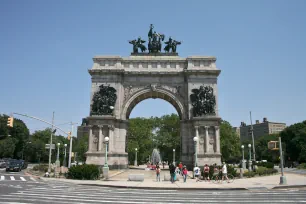
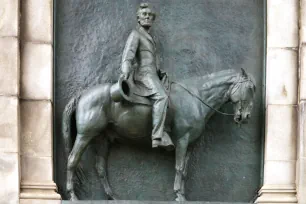
Designed in 1867 by Frederick Law Olmsted (of Central Park fame) and Calvert Vaux (who also assisted with Central Park), Grand Army Plaza is an 11-acre (4.5 ha) area that was designed as the main entrance to Brooklyn’s well-known Prospect Park. This oval plaza consists of concentric rings, from which eight radial road emerge. Flatbush Avenue forms the inner ring.
The creators had hoped that the plaza would serve to isolate the park and keep the noise to a minimum so that visitors to the park could enjoy peace and quiet. The gateway to Prospect Park however failed as the great urban plaza it was meant to be due to the hectic traffic surrounding it, making it hazardous for pedestrians to reach the plaza. Fortunately, plans to make the area more pedestrian friendly are in the works.
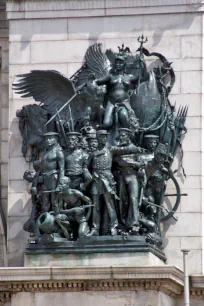
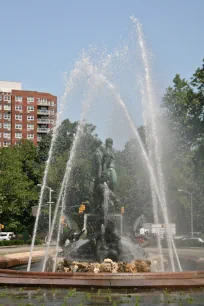
Sights
Soldiers’ and Sailors’ Monument
The centerpiece of the plaza is what many have called Brooklyn’s Arc de Triomphe – The Soldiers’ and Sailors’ Monument. Not to be confused with the one of the same name in Manhattan’s Riverside Park, this one was designed by John H. Duncan, whose creation was chosen from 36 entries. Duncan later went on to design Grant’s Tomb.
It took three years to build the arch, which was opened in 1892. The 27-meter-high monument honors Union Army soldiers who served during the Civil War.
Inside the arch are wonderful equestrian relief sculptures of Lincoln and Grant, sculpted by William Rudolf O’Donovan and Thomas Eakins (the latter did the horses). The statues that sit about halfway up the arch represent “The Spirit of the Army” and “The Spirit of the Navy”. They were added around 1900 and were designed by Frederick MacMonnies. He also created the Quadriga, which sits on top of the arch and depicts “Columbia”, who is generally used as an allegorical representation of the U.S. She sits upon a chariot which is drawn by two horses and is surrounded by winged Victory figures.
Bailey Fountain
To the north of the Soldiers and Sailors Monument sits Bailey Fountain, first placed at the site in 1932. It was designed by architect Edgerton Swarthout and sculptor Eugene Francis Savage but named after local financier and philanthropist Frank Bailey, who financed the fountain.
A popular spot for wedding photos, the fountain shows a man, woman (representing wisdom and felicity) and a boy holding a cornucopia. They stand on top of the prow of a ship, surrounded by Neptune – god of the sea – and a Triton.
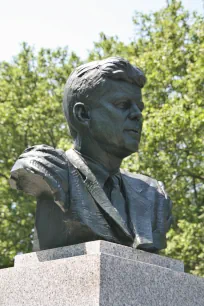
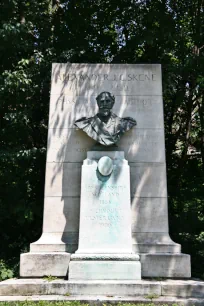
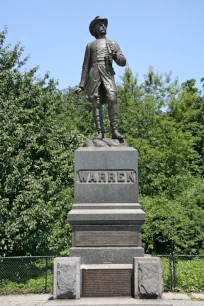
John F. Kennedy Memorial
Just north of the Bailey fountain stands a memorial honoring John F. Kennedy, the thirty-fifth President of the United States, who was assassinated in 1963. The memorial consists of a bronze bust of the president, sculpted by the American artist Neil Estern, who is best known for his sculpture of President Franklin D. Roosevelt in Washington, DC. The bust was dedicated here on May 31, 1965, but it began to deteriorate quickly due to poor construction, so in 2010 a modified bust was placed here on a new granite pedestal, also designed by Estern. The foot of the pedestal is inscribed with one of Kennedy’s most memorable quotes: “Ask not what your country can do for you – ask what you can do for your country.”
More memorials
On the traffic islands around the main oval that is home to the above-mentioned monuments, are several other monuments worth mentioning.
One, on the north side, honors Dr. Alexander J.C. Skene, a Brooklyn-based physician of Scottish origin. The monument was commissioned by a committee of physicians and shows a bust of Dr. Skene set on a pedestal in front of a stele. The bronze bust was sculpted in 1905 by John Massey Rhind, a Scottish-American sculptor.
On the east side of Grand Army Plaza stands a large equestrian monument dedicated to General Henry Warner Slocum. The general is shown holding a raised saber. The statue, created by the American Beaux-Arts sculptor Frederick William MacMonnies, rests on a large granite pedestal that is decorated with bronze medallions and rises to a height of 17 feet (5 meters). The monument was dedicated here on May 30, 1905.
Another general from the American Civil War era is honored with a statue on the south-east side of Grand Army Plaza: General Gouverneur Kemble Warren. His sculpture was the work of Henry Baerer, an American sculptor of German descent. It shows the general holding binoculars while standing on a tall granite pedestal. The monument was created in 1893 and dedicated here three years later, on June 26, 1896.
Brooklyn Public Library
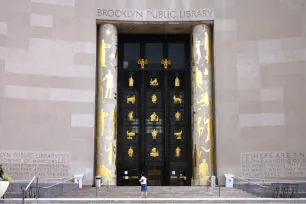
On the south-east corner of the plaza sits Brooklyn’s Central Library, the largest in the borough’s public library system. The library opened its doors in 1941 and is a New York City Landmark. It is an imposing limestone building, meant to resemble an open book.
The building is decorated with Art Deco elements. Most remarkable is its enormous 50-foot / 15-meter-high portico, which features gilded reliefs that resemble Egyptian hieroglyphs. They represent the evolution of art and science. Gilded sculptures on the doors represent famous authors and characters from American literature.

